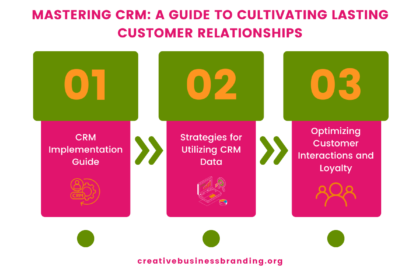Mastering CRM: A Guide to Cultivating Lasting Customer Relationships

In today’s fast-paced business world, staying connected with your customers is more important than ever. Customer Relationship Management (CRM) systems are not just tools; they are the backbone of a business’s ability to maintain detailed customer profiles and deliver enhanced service experiences. This guide, along with our YouTube series, offers practical tips and strategies to help you harness the full potential of CRM systems.
1. CRM Implementation Guide
A well-implemented CRM system is the foundation of effective customer relationship management. Here’s how to get started:
- Choosing the Right Software: Select a CRM platform tailored to your business size, industry, and goals. Popular options include Salesforce, HubSpot, and Zoho CRM.
- Integration with Digital Tools: Ensure your CRM integrates seamlessly with tools like email marketing software, social media platforms, and analytics dashboards.
- Staff Training: Equip your team with the knowledge to use CRM effectively. Training sessions and user-friendly interfaces can make the transition smooth and efficient.
Pro Tip: Create a roadmap for your CRM implementation to ensure all team members are aligned.
2. Strategies for Utilizing CRM Data
Your CRM system is a treasure trove of insights. Here’s how to turn that data into actionable strategies:
- Analyze Customer Preferences: Use CRM analytics to understand buying patterns, communication preferences, and feedback trends.
- Segment and Target: Divide your audience into segments based on behavior, demographics, or purchase history to create personalized marketing campaigns.
- Case Study: A local retail business increased sales by 25% after using CRM data to identify and reward its most loyal customers.
3. Optimizing Customer Interactions and Loyalty
CRMs are powerful tools for elevating customer service and retention efforts.
- Improved Customer Support: Use detailed customer profiles to provide faster and more personalized support.
- Loyalty Programs: Automate and manage loyalty programs directly through your CRM to reward repeat customers and increase retention.
- Real-Time Feedback: Track customer satisfaction through surveys and adapt your services based on feedback.
Example: A restaurant chain used CRM tools to offer personalized discounts to customers based on their dining preferences, resulting in a significant boost in repeat visits.
Conclusion
A robust CRM strategy is more than a business asset; it’s a game-changer for customer satisfaction and growth. By implementing a CRM system, analyzing data effectively, and optimizing interactions, businesses can create lasting customer relationships that drive success.
Take the Next Step!
Book a consultation to learn how to integrate CRM with your existing marketing efforts.
For more actionable insights and real-world examples, check out our YouTube series, “Mastering CRM: A Guide to Cultivating Lasting Customer Relationships.”
Your journey to smarter, data-driven customer relationships begins now!
This guide is designed to empower small business owners with the tools they need to better manage customer data, improve marketing efforts, and deliver unforgettable customer experiences.
